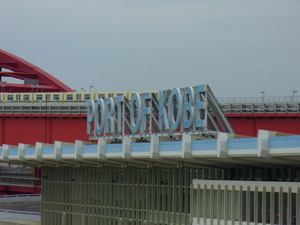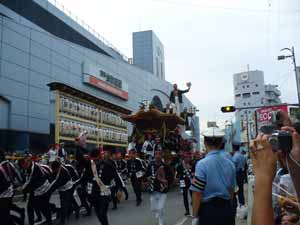TABLE
OF CONTENTS
|
Japan
By Kristin Trapp

Japan’s
urbanism was not as easily
seen as I had imagined it would be. As I
was walking through the many unmarked streets of Japan
I began to look for distinct
markings and buildings that really shouted transnational or vernacular
urbanism. Much to my dismay it was not
that simple. I had to then look for some
of the dimensions of global cultural flow including ethnoscapes,
mediascapes, and
finanscapes, and not all of them were as easily visible as I had
anticipated
either.
Ethnoscapes
are the ways tourists, immigrants, refugees and guest workers move
about a
city. This was challenging to observe
since 99.3% of Japan's population is native Japanese.
The only tourists I witnessed were either
students of Semester at Sea or in some way affiliated with the program. Immigrants were also hard to observe within
the cities. I only saw three people that
to the best of my knowledge were immigrants and they were players on
the
Japanese baseball team. Refugees and
guest workers were also some what of a rare commodity, so if I was
going to
learn more about the city I had better look to another dimension, for
instance
mediascapes.
Mediascapes
are the worldwide distribution of information through newspapers,
magazines, TV
program and films. This was not as hard
to observe since there were TVs, newspapers and magazines everywhere,
the only
problem was I don’t speak or read Japanese, so to the best of my
knowledge the
mediascapes for Japan do have a world wide distribution of information. However, the advertisements that were posted
every where were in English. This
brought me to my last dimension, finanscapes. 
Finanscapes
are the global capital flow. Japan
really
shocked me when it came to its cities. I
never did make it to Tokyo
but I do not really feel that I missed out since four out of the five
cities
that I did visit could be classified as large scale urban cities. Every square inch of property was covered
with concrete and skyscrapers filled the skies. This
really surprised me since I was expecting Japan’s
cities
to be filled with rice fields and temples, not international businesses
and
large scale buildings. The most shocking
observation I made about Japan’s
cities was the conglomeration of the buildings. Walking
down any given street I could pass an ancient
temple, a new
apartment building, a moderately older house a rice field and the Gap,
or some
other international business. Walking
through the city I really grasped what Theodore C. Bestor was talking
about in
his paper on “Supply-Side Sushi: Commodity, Market, and the Global City.” I
could really understand what Bestor was
talking about and I could see how even with the tuna exports and
imports how
important it is to be a global city. The
daily lives of the people would be greatly effected without the
exportation.
The
way Japanese cities were laid out really surprised me. To
be able to walk around and witness palaces
and temples that had existed for hundreds of years co-existing with the
new
technology that today’s architecture has to offer was astonishing. Time and technology really has had an impact
on the way Japan’s
cities operate, although the time honored traditions are still
prevalent.
|


